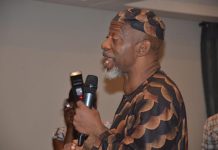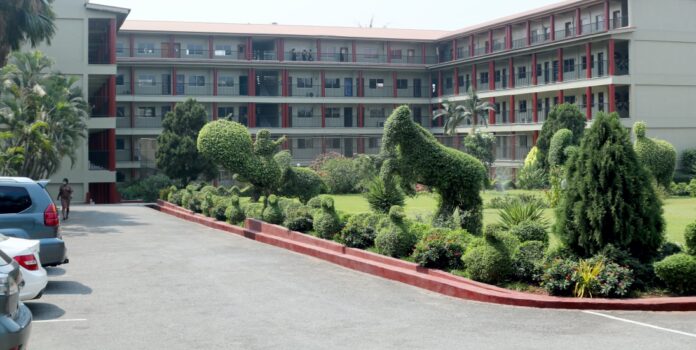Vivian Fowler Memorial College students have been very active in the technology space, particularly blazing trails in robotics. With the school club, TechnoBot, the girls have recorded many firsts, including building apps, websites, setting up robotics programmes for other schools and participating in various competitions both nationally and internationally. Timeless Magazine visited the school recently and chat with the Administrator, Mrs Olufunke Fowler-Amba and members of the TechnoBot team.
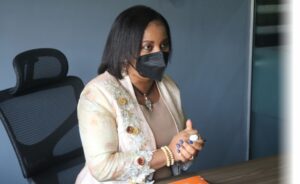 Fowler-Amba in a chat with Edirin Etaghene discussed approach to teaching the new generation who she called the digital villagers, importance of training the girl child and the need for the government to make education a priority in its policy direction.
Fowler-Amba in a chat with Edirin Etaghene discussed approach to teaching the new generation who she called the digital villagers, importance of training the girl child and the need for the government to make education a priority in its policy direction.
Can you tell us what led to the establishment of Vivian Fowler Memorial College?
Vivian Fowler was started by Chief Dr. (Mrs) Leila Fowler. She is very passionate about the advancement of girl child education. She founded this school about 30 years ago.
So is it an all girls’ school?
I don’t think it is gender bias because I think that in her quest to make the female gender become more accessible in the corridors of power, she realised that you probably needed institutions like ours, which focus on the girl child. Because there is gender bias, and a lot of resources are not being spent on the female child. So, it was just a place where she was able to align a vision that will allow the girl child to be a professional, also to be a mother and to progress significantly in her career. Because that is the kind of journey she had. She started as a lawyer and mother of children and understood that she can actually balance both.
You have been an administrator for how long?
Probably about 7 years.
What are the challenges you faced as the school administrator?
Like anything else, it comes with a lot of challenges, but most importantly, the school has had to shift the way we as educators identify with our children. The relationship has progressed more from secondary parents to everybody within the community being part of pastoral care. This is because the position of secondary parents now requires more responsibilities as the family unit within our environment has changed significantly. I think a lot of the challenges we see are probably with what I call the new generation, which is the generation X,Y and Z, and then millenniums, where the way you approach them and communicate to them is completely different. Their needs are a lot different as well.
So how have you been able to overcome all these challenges?
We have had to look inwardly and we did a lot of training to understand them better and improve our communications skills. We understand that it’s a generation that needs a lot of engagement. They are a very creative generation and they are probably the first digital villagers. So with them being the digital villagers, we had to make sure that there wasn’t an imbalance. Even our staff have had to go through a lot of rigorous technology training so that we would be able to meet their needs.
This is in terms of relationship with the children internally, what about government policy?
I think that sometimes the government does not identify with the challenges that private schools have to go through. We don’t get tax breaks for instance, and we don’t get grants to supplement them. I think there is a bias thinking that there is a lot of profit and material gain in owning schools. I think a lot of people, and I am speaking on behalf of other private institutions, say that if you don’t like children, you can’t really do this job. The government needs to realise that in our quest to educate the children, which they don’t have the capacity to educate all, they should be a bit more sympathetic that we are helping to educate a large group of children. For instance, look at Lagos State in 2015, where we recorded about 25 million people, there is no way the government can educate all those people. I don’t think they support us enough and they even classify us differently. They are not even giving us any consensus. So I think that the government needs to see the private and public sector as a form of partnership because at the end of the day, everybody, whether you are in either sector, we are always going to end up in the same workplace, so it is really about the progress of our country.
Stakeholders in the sector have become critical about the falling standard of education in Nigeria, do you agree with that assessment?
I think sometimes we are too hard on ourselves. We have to look at it in a different way because we have limited infrastructure and these children when they leave the shores of Nigeria, they excel. So I don’t think we should be hard on ourselves. I think what we need to do is for the government to make education a priority. If you look at the United Nations Sustainable Development Goals, which prescribed what the government is supposed to invest in education, it is quite a large amount, but we are not doing a quarter of that. So I think it should be our priority because we have a very young population.
 Vivian Fowler will soon mark its 30 years of existence, what are your projections for the future?
Vivian Fowler will soon mark its 30 years of existence, what are your projections for the future?
Well, we pray that the legacy of the owner which is to educate the girl-child continues. I think there are misconceptions within Nigeria. The mindset is that the older you are in business, the less productive you are. But we are happy to say that we have progressed. We have not digressed from values.
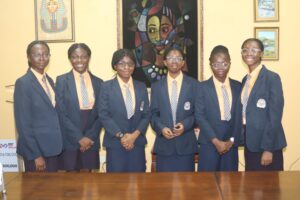 Timeless Magazine chatted with members of the school TechnoBot team. The team is a frontrunner in robotics development among schools in the country. They have participated in several competitions within the country and represented Nigeria in various international tournaments winning laurels and recognitions. The captain, Adeyimika Adebayo spoke about their innovative ideas, apps they have created, various undertakings to deepen robotics appreciation among students and the team exploits in competitions.
Timeless Magazine chatted with members of the school TechnoBot team. The team is a frontrunner in robotics development among schools in the country. They have participated in several competitions within the country and represented Nigeria in various international tournaments winning laurels and recognitions. The captain, Adeyimika Adebayo spoke about their innovative ideas, apps they have created, various undertakings to deepen robotics appreciation among students and the team exploits in competitions.
What can you tell us about TechnoBot and what you do as a team?
We see ourselves as more than a team, but as a family of God. We term ourselves with the acronym LIT, which is, we are logical, innovative and transparent. We rely on one another and grow one another. It was established in 2017 and compared to the scale of communication skills that we had then, we have grown a lot as a team. Compared to who I was as a person in 2017, I was just a member and quite laid back in the shadows, I was not that upfront and confident. But over the years, getting to grow with my classmates and even my juniors, I was able to develop myself in different aspects. I not only developed leadership skills, but also acquired skills that make me an asset to my team.
As a team what we do is much more than just compete in competitions to win, we view ourselves as a corporation. We have different divisions. For instance, Ayomide, one of my team members, is the head of outreach, Sarah is the head of media, I am the team captain and other people here are heads of building, electronics and quality control. As a robotic team, we do not just build robots to compete for competitions and win and then disband when the season is over, but from the very second that we decided to become the TechnoBot, we became a family that communicated throughout the year, even during holidays.
So far, part of our objectives is to scan for competitions, help other schools that do not have robotic programmes, and develop it for them, which is what we did last season. We sponsored a school to build their robotic programme. We donated some of our kits and raised some money for them. That was our outreach project for one of our competitions. Our dream is to be the face of technology in Africa.
Why tech and robots?
Because we have the skills to take over the world in technology. Obviously, as girls in general, women usually are not seen in those kinds of positions where they are talking about heading those kinds of corporations or even belonging to tech groups. But as a team, when we first met, we realised that we all have unique capabilities, whether it is someone who can code or great at copying a robot or at handling someone’s finances. So why tech? Because the future of tech is the girl-child. The girl-child is more than equipped to do anything that she wants to do. The tech industry is lacking the essence of the girl child and as a team, we know that if we perform well, we can inspire other girls who are hiding behind the shadows to come forward. It is not just about competing for ourselves, but we also want to help other girls around the world to see that they are more than enough and capable to do whatever they want to do.
So what do you hope to achieve with the robot you built and what contributions are you hoping that its development or inventions will make?
Each season we have a different theme for the competition. The theme for this year is about transportation. The robot that we are coupling is not just to compete for the competition itself, but our research and the structure of our robot and the way it reacts to certain things on the field should be related to improving transportation in some kind of way.
Each season we focus on trying our very best to relate what the theme is, to what our robot does and to what we focus on, like our outreaches. For this year the theme is ‘five frenzy’ which is about improving transportation. We have a team, which is the first Lego league. We are the first tech challenge team. The first level league (FLL) team, for instance, is building an app to help improve and track your packages when they are being transported. A few seasons ago, when we were in the FLL team, because we were all in FLL together, we made an app called Tech-circle. It was an app that was going to connect sanitation workers to the government and citizens in general, because we understood that there was so much that the government could do.
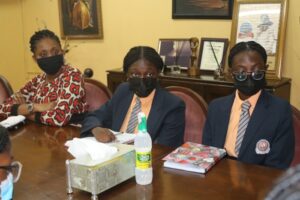 We build apps and websites, we have social media platforms, we reach out to other international teams, and we compete in international and national competitions whether physical or virtual, which is what we did last season. We had a virtual competition that was hosted in Australia, but we competed upstairs in our lab and it was definitely a challenge as we had to compete from 11pm to 6am Nigeria time. But because of the time difference, it was a challenge. There was definitely a lot to do, but if I am being frank, I do not regret a thing from that challenge.
We build apps and websites, we have social media platforms, we reach out to other international teams, and we compete in international and national competitions whether physical or virtual, which is what we did last season. We had a virtual competition that was hosted in Australia, but we competed upstairs in our lab and it was definitely a challenge as we had to compete from 11pm to 6am Nigeria time. But because of the time difference, it was a challenge. There was definitely a lot to do, but if I am being frank, I do not regret a thing from that challenge.
Can you tell us more about the competitions you have taken part in and how it turned out?
In 2017, our first competition was the Robo Rave Nblock competition in Ogun State and we came first in the Sumo Bot Challenge. Three of us were there and we were in JSS2 at that time, that is how much we have been dedicated to robotics. We participated in other national competitions in Lagos and other semi finals before we were able to attend Haven Tech in America in 2017/2018. About 70 countries participated with over a thousand teams. We placed in the top 20 team in 200 in our division (Sumo Bot Challenge).
We also came first in a debate in Robo Ethics Challenge, where we came first with a cash prize of $1000. After that was the First Lego League (FLL) in February 2020, which was hosted by an organisation called First in Abuja. At the competition, we came first in an innovation project. This was where we created an app centred around pyrolysis, which is a process that effectively turns waste into green products and could be used like natural gas and we made the app that was going to connect sanitation workers to citizens. For instance, if you are walking down the street and you see trash, instead of feeling helpless and not being able to properly pack it up and dispose of it, you will have the opportunity to connect directly with the nearest sanitation worker in that area. They will come, pack it up and leave. And if we were to develop that concept, the more you do that, the more points you get and if you get a particular amount of points, then there could be a prize from the government for you. So that was the concept of our app.
In 2019 we went for a national Nblock competition called Nblock Jousting and we came second, it was held in Lagos.
We were supposed to go for a competition in China but it was cancelled because of COVID-19 in 2021.
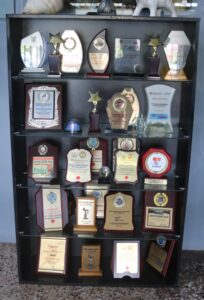 In 2021 we participated in First Tech Challenge (FTC), Asia Pacific Open Championship (APOC) Australia government challenge. It was our first time participating in an FTC competition, and unfortunately, we were not informed that we were competing until three weeks before the tournament. We do not like to talk about it as a disadvantage, because anyone could do anything. But other teams have been preparing for months and we were the only African team, an all-girl team. So there were definitely a lot of expectations on us. We literally dismantled and rebuilt the robot a night before the competition and we performed extremely averagely. I will admit, in the robot game itself, we performed very averagely and we didn’t place in any position. But in the other aspects, there were a lot of side games, we placed really high like second place in quite a few of the side quests.
In 2021 we participated in First Tech Challenge (FTC), Asia Pacific Open Championship (APOC) Australia government challenge. It was our first time participating in an FTC competition, and unfortunately, we were not informed that we were competing until three weeks before the tournament. We do not like to talk about it as a disadvantage, because anyone could do anything. But other teams have been preparing for months and we were the only African team, an all-girl team. So there were definitely a lot of expectations on us. We literally dismantled and rebuilt the robot a night before the competition and we performed extremely averagely. I will admit, in the robot game itself, we performed very averagely and we didn’t place in any position. But in the other aspects, there were a lot of side games, we placed really high like second place in quite a few of the side quests.
We could also mention the fact that though we may have done so averagely in the robot game itself, the exposure the competition gave us meant so much more than the robot game itself because of the fundraising and outreach projects that we were able to achieve and accomplish last year. We were able to market our team to be able to get so many sponsors raising up to millions of naira. The Administrator, Mrs Fowler-Amba was very supportive throughout the entire time. She reached out to a lot of organisations and individuals who were more than happy to sponsor us like Sterling bank and various individuals like Mrs Bello Osagie.
You participated in a Lego competition last year, how did it go?
The competition was held early last year. Though it was originally scheduled for 2020, but because of the COVID-19 pandemic, we could not exactly have it then. So we started in the early part of 2021 and ended towards the end, from January to September.
When the competition started we weren’t given an idea of what we were doing. First, they wanted to get to know us as people. So we went through a series of interviews. They learnt more about us and they hinted to us a little bit about what the challenge would be all about because we were supposed to work with other teams around the world. There was a team each from Sweden, California, Japan, and Nigeria. The four teams were to work together and we had not met any of the other teams. But they interviewed everyone on our team individually. We were an 8-person team and this was the Nigeria team, so we were representing Africa. The competition notice was released sometime in February and we were given about a month to come up with an idea using Legos to move a 50 tonnes truck. The competition was sponsored by Lego and Revo. It was not a competition as it was more of a challenge and the name was Lego-move-it Challenge.
It was originally meant to be 50tonnes but it was increased to 100 tonnes. It was later in the challenge they told us that they are going to bring it up to 100 tonnes by putting in 50tonnes worth of cargo in the back of the truck so we later had to move 100 tonnes with Legos.
The competition had different stages. The first stage was brainstorming. Every team person met each other and we got to know each other better then after, we went back individually as team members and we brainstormed on ideas. We received packages from Lego, but we could only use the boxes that they gave us. So every single person got an individual box which we could mix together and make prototypes.
We were to make prototypes, have meetings, give back information, give ideas, send pictures, videos and just send anything that we thought could move us closer to solving the challenge.
As the weeks went by, different teams brought forth different ideas. Some teams thought it would be better if we had a pulley system that we could pull the truck or push the truck. But at the end of the day, we decided that we were going to try and pull the truck because that seemed more efficient because Lego is quite brutal.
We faced a lot of challenges, first of all, it was communication. Working cross countries is not always the best, because of the different time zones, so we had to wake up at odd hours. We had to wake up at times at 5am and get ready for 6am or 7am meetings. At other times when we were lucky, the meetings were scheduled for 8am or maybe there would be some problems and we had to login at 8pm. But the whole essence of that was just to make sure that everybody could talk to one another because we were all making sacrifices to be in that meeting. This was for us to come together, share notes, ideas, go back, work on it and keep each other updated. It was a way to build new relations, talk to people that you won’t necessarily have talked to and just make new connections.
While we were preparing for all of these, we came together and decided we were going to merge our designs together and that was the tricky part. We did all of that and luckily we got the first testing staged, our designs were sent to Lego and we got a lot of skilled workers to help us build the project. They used thousands of Lego and they built our prototypes. They decided to try and move a mini version of the truck, moving 20 tonnes instead of 100 tonnes. When they tried for the first time, sadly it failed and we all went back to the drawing board and tried it again. The engineers already gave us advice, we asked questions and decided to take off the wheels. We took off the fibre part of the wheels, because they kept on melting due to the pressure put on it. So we took that off and then decided to try something that was not conventional, something that you won’t normally do. It was not normal, but it was the way forward. We planned, double checked and made sure nothing was going to go wrong and then we tried it again. When we tried it for the second time, it pulled the truck 10 centimetres and we were supposed to pull that truck 15 metres. But we pulled it 10 centimetres before the motor stopped working and burnt out. That problem was actually not more of a design structural problem, it was more like a technical difficulty because the land was not flat.
Therefore, we had to take everything back to Lego headquarters and make sure the roads were smooth. It took a lot of planning, but we came back and did it again, and much to our surprise, it worked and moved even farther than it needed to with the pressure. Even at the end of our challenge, the Lego prototypes were still in perfect condition and with all the months of hard work we came and we got to our goal.
You put in so much energy and time, so what were the rewards?
There was not any monetary reward, but we got to keep those kits that were sent to us as it was free. They also sent us individual cameras and we were allowed to keep them. At the end of the competition, they sent us another set of celebratory kits from Lego, and while there was not exactly a monetary prize, we got so much more in terms of experience, new connections, friends and we earned more than we would have.
You have come up with a number of projects and apps, do you know if any of your apps or robots or developments have been put to use practically in the real world?
The ideas that we had are all about implementing them right? They are very nice ideas, but it is about making them physical so it takes a whole lot of planning. Right now we are in the stage of finding people and connecting them together. It is about finding the right people and giving them access to our apps and these apps can be really accessible. We have them with us, but it is just about finding the right connections and trying to bring people together and making the best use of what we have created so we are currently in that stage right now, which is just trying to find and make connections with people and making the best use of what we have.
We are perfecting our project before going on to making it available to the world to use personally. For now the purpose of our work is for competitions, not necessarily for the real world.
The most appropriate things we have done have been our outreaches, including making communities where international teams can come to us. We are going around Lagos as a whole and hopefully we will be going around Nigeria soon. We are going around Lagos finding schools that need support in building a robotics programme, so that is the most applicable move. We are raising money for other people, raising money for ourselves, reaching out to other teams, even those that we are competing against and improving each other.
For example, our last community outreach was basically about sharing friends with people who do not exactly know about us and we did that through ‘Our kids for all’ programme. It was a programme where we got sponsorship by doing a big sale so that we could raise money to purchase a kit for a school called Canon James Anglican school. We helped them to start their competitions and this term, we also planned to go on and continue to help in that sense.
How many people are in your team?
We are 17 in number and all of us are from within this school.



